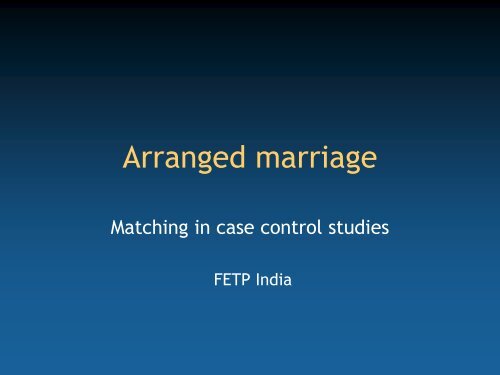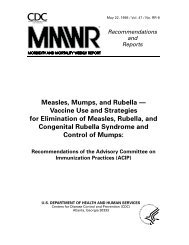Matching in case control studies - The INCLEN Trust
Matching in case control studies - The INCLEN Trust
Matching in case control studies - The INCLEN Trust
- No tags were found...
Create successful ePaper yourself
Turn your PDF publications into a flip-book with our unique Google optimized e-Paper software.
Arranged marriage<br />
<strong>Match<strong>in</strong>g</strong> <strong>in</strong> <strong>case</strong> <strong>control</strong> <strong>studies</strong><br />
FETP India
Competency to be ga<strong>in</strong>ed<br />
from this lecture<br />
Design and analyze a matched<br />
<strong>case</strong> <strong>control</strong> study
Key elements<br />
• <strong>The</strong> concept of match<strong>in</strong>g<br />
• <strong>The</strong> matched analysis<br />
• Pro and cons of match<strong>in</strong>g
Controll<strong>in</strong>g a confound<strong>in</strong>g factor<br />
• Stratification<br />
• Restriction<br />
• <strong>Match<strong>in</strong>g</strong><br />
• Randomization<br />
• Multivariate analysis<br />
<strong>The</strong> concept of match<strong>in</strong>g
<strong>Match<strong>in</strong>g</strong>: concept<br />
• Confound<strong>in</strong>g is anticipated<br />
• Adjustment will be necessary<br />
• Preparation of the strata a priori<br />
• Recruitment of <strong>case</strong>s and <strong>control</strong>s<br />
• By strata<br />
• To ensure sufficient strata size<br />
<strong>The</strong> concept of match<strong>in</strong>g
Why match<strong>in</strong>g<br />
• If <strong>case</strong>s and <strong>control</strong>s are similar for the<br />
match<strong>in</strong>g variables,<br />
• <strong>The</strong>n, differences must be otherwise<br />
expla<strong>in</strong>ed.<br />
<strong>The</strong> concept of match<strong>in</strong>g
Consequences....<br />
• <strong>The</strong> problem:<br />
• Confound<strong>in</strong>g<br />
• Is solved with another problem:<br />
• Introduction of more confound<strong>in</strong>g,<br />
• so that stratified analysis can elim<strong>in</strong>ate it.<br />
<strong>The</strong> concept of match<strong>in</strong>g
<strong>Match<strong>in</strong>g</strong>: Def<strong>in</strong>ition<br />
• Creation of a l<strong>in</strong>k between <strong>case</strong>s and<br />
<strong>control</strong>s<br />
• This l<strong>in</strong>k is:<br />
• Based upon common characteristics<br />
• Created when the study is designed<br />
• Kept through the analysis<br />
<strong>The</strong> concept of match<strong>in</strong>g
Types of match<strong>in</strong>g strategies<br />
• Frequency match<strong>in</strong>g<br />
• Large strata<br />
• Set match<strong>in</strong>g<br />
• Small strata<br />
• Sometimes very small (1/1: pairs)<br />
<strong>The</strong> concept of match<strong>in</strong>g
<strong>Match<strong>in</strong>g</strong>:<br />
False pre-conceived ideas<br />
<strong>Match<strong>in</strong>g</strong> is necessary for all <strong>case</strong>-<strong>control</strong><br />
<strong>studies</strong><br />
<strong>Match<strong>in</strong>g</strong> needs to be done on age and sex<br />
<strong>Match<strong>in</strong>g</strong> is a way to adjust the number of<br />
<strong>control</strong>s on the number of <strong>case</strong>s<br />
<strong>The</strong> concept of match<strong>in</strong>g
<strong>Match<strong>in</strong>g</strong>:<br />
True statements<br />
<strong>Match<strong>in</strong>g</strong> can put you <strong>in</strong> trouble<br />
<strong>Match<strong>in</strong>g</strong> can be useful to quickly recruit<br />
<strong>control</strong>s<br />
<strong>The</strong> concept of match<strong>in</strong>g
<strong>Match<strong>in</strong>g</strong> criteria<br />
• Potential confound<strong>in</strong>g factors<br />
• Associated with exposure<br />
• Associated with the outcome<br />
• Criteria<br />
• Unique<br />
• Multiple<br />
• Always justified<br />
<strong>The</strong> concept of match<strong>in</strong>g
Example:<br />
Risk factors for microsporidiosis<br />
among HIV-<strong>in</strong>fected patients<br />
• Case <strong>control</strong> study<br />
• Exposure<br />
• Food preferences<br />
• Potential confounder<br />
• CD4 / mm3<br />
• <strong>Match<strong>in</strong>g</strong> by CD4 category<br />
• Analysis by CD4 categories<br />
<strong>The</strong> concept of match<strong>in</strong>g
Mantel-Haenszel adjusted odds ratio<br />
a i .d i ) / Ti]<br />
OR M-H =<br />
b i .c i ) / Ti]<br />
Matched analysis
Matched analysis by set<br />
(Pairs of 1 <strong>case</strong> / 1 <strong>control</strong>)<br />
• Concordant pairs<br />
• Cases and <strong>control</strong>s have the same exposure<br />
• No ad and bc: no <strong>in</strong>put to the calculation<br />
Cases Controls Total<br />
Exposed 1 1 2<br />
Non-exposed 0 0 0<br />
Total 1 1 2<br />
No effect<br />
Cases Controls Total<br />
Exposed 0 0 0<br />
Non-exposed 1 1 2<br />
Total 1 1 2<br />
No effect<br />
Matched analysis
Matched analysis by set<br />
(Pairs of 1 <strong>case</strong> / 1 <strong>control</strong>)<br />
• Discordant pairs<br />
• Cases and <strong>control</strong>s have different exposures<br />
• ad’s and bc’s: <strong>in</strong>put to the calculation<br />
Cases Controls Total<br />
Exposed 1 0 1<br />
Non-exposed 0 1 1<br />
Total 1 1 2<br />
Positive association<br />
Cases Controls Total<br />
Exposed 0 1 1<br />
Non-exposed 1 0 1<br />
Total 1 1 2<br />
Negative association<br />
Matched analysis
<strong>The</strong> Mantel-Haenszel odds ratio...<br />
OR M-H =<br />
a i .d i ) / Ti]<br />
b i .c i ) / Ti]<br />
Matched analysis
…becomes the matched odds ratio<br />
OR M-H =<br />
Discordant sets <strong>case</strong> exposed<br />
Discordant sets <strong>control</strong> exposed<br />
Matched analysis
…and the analysis can be done<br />
with paper clips!<br />
• Concordant questionnaire : trash<br />
• Discordant questionnaires : on the scale<br />
• <strong>The</strong> "exposed <strong>case</strong>" pairs weigh for a positive<br />
association<br />
• <strong>The</strong> "exposed <strong>control</strong>" pairs weigh for a negative<br />
association<br />
Matched analysis
Analysis of matched <strong>case</strong> <strong>control</strong> <strong>studies</strong><br />
with more than one <strong>control</strong> per <strong>case</strong><br />
• Sort out the sets accord<strong>in</strong>g to the exposure<br />
status of the <strong>case</strong>s and <strong>control</strong>s<br />
Example for 1 <strong>case</strong> / 2 <strong>control</strong>s<br />
Sets with <strong>case</strong> exposed: +/++, +/+-, +/--<br />
Sets with <strong>case</strong> unexposed: -/++, -/+-, -/--<br />
• Count reconstituted <strong>case</strong>-<strong>control</strong> pairs for<br />
each type of set<br />
• Multiply the number of discordant pairs <strong>in</strong><br />
each type of set by the number of sets<br />
• Calculate odds ratio us<strong>in</strong>g the f/g formula<br />
Matched analysis
<strong>The</strong> old 2 x 2 table...<br />
Cases Controls Total<br />
Exposed a b L1<br />
Unexposed c d L0<br />
Total C1 C0 T<br />
Odds ratio: ad/bc<br />
Matched analysis
Cases<br />
... is difficult to recognize!<br />
Controls<br />
Exposed Unexposed Total<br />
Exposed e f a<br />
Unexposed g h c<br />
Total b d P (T/2)<br />
Odds ratio: f/g<br />
Matched analysis
<strong>The</strong> Mac Nemar chi-square<br />
Chi 2 McN=<br />
(f - g) 2<br />
(f+g)<br />
Matched analysis
<strong>Match<strong>in</strong>g</strong>: Advantages<br />
• Is easy to communicate<br />
• Is useful for strong confound<strong>in</strong>g factors<br />
• Can <strong>in</strong>crease the power of small <strong>studies</strong><br />
• Can ease <strong>control</strong> recruitment<br />
• Is useful if only one factor is studied<br />
• Allows look<strong>in</strong>g for effect modification with<br />
match<strong>in</strong>g criteria<br />
Pro and cons
<strong>Match<strong>in</strong>g</strong>: Inconvenience<br />
• Must be understood by the author<br />
• Is deleterious <strong>in</strong> the absence of confound<strong>in</strong>g<br />
• Can decrease power<br />
• Can complicate <strong>control</strong> recruitment<br />
• Is limit<strong>in</strong>g if more than one factor<br />
• Does not allow exam<strong>in</strong><strong>in</strong>g the association<br />
with the match<strong>in</strong>g criteria<br />
Pro and cons
<strong>Match<strong>in</strong>g</strong> with a variable associated with<br />
exposure, but not with illness<br />
(Overmatch<strong>in</strong>g)<br />
• Reduces variability<br />
• Increases the number of concordant pairs<br />
• Has deleterious consequences:<br />
• If matched analysis: reduction of power<br />
• If match broken: Odds ratio biased towards one<br />
Pro and cons
Hidden match<strong>in</strong>g<br />
(“Crypto-match<strong>in</strong>g”)<br />
• Some <strong>control</strong> recruitment strategies consist<br />
de facto <strong>in</strong> match<strong>in</strong>g<br />
• Neighbourhood <strong>control</strong>s<br />
• Friends <strong>control</strong>s<br />
• <strong>Match<strong>in</strong>g</strong> must be identified and taken <strong>in</strong>to<br />
account <strong>in</strong> the analysis<br />
Pro and cons
<strong>Match<strong>in</strong>g</strong> for operational reasons<br />
• Outbreak <strong>in</strong>vestigation sett<strong>in</strong>g<br />
• Friends or neighbours <strong>control</strong>s are a common<br />
choice<br />
• Advantages:<br />
• Allows identify<strong>in</strong>g <strong>control</strong>s fast<br />
• Will take care of gross confound<strong>in</strong>g factors<br />
• May result <strong>in</strong> some overmatch<strong>in</strong>g, which places<br />
the <strong>in</strong>vestigator on “the safe side”<br />
Pro and cons
Break<strong>in</strong>g the match<br />
• Rationale<br />
• <strong>Match<strong>in</strong>g</strong> may limit the analysis<br />
• <strong>Match<strong>in</strong>g</strong> may have been decided for operational<br />
purposes only<br />
• Procedure<br />
• Conduct matched analysis<br />
• Conduct unmatched analysis<br />
• Break the match if the results are unchanged<br />
Pro and cons
Take-home messages<br />
• <strong>Match<strong>in</strong>g</strong> is a difficult technique<br />
• <strong>Match<strong>in</strong>g</strong> design means matched analysis<br />
• <strong>Match<strong>in</strong>g</strong> can always be avoided

















